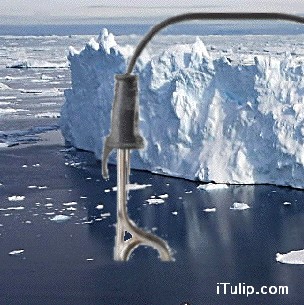 |
Fear never financed asset price inflation, but governments have
The common wisdom is that markets are driven by greed and fear. My observation is that markets are in fact driven by fear and fear, two kinds: fear of taking losses on past gains and fear of missing out on future gains. Call one loss-fear and the other greed-fear.
The bull-biased business press is financed with advertising by financial services firms that primarily sell equities-based mutual funds and stock index funds products, stock brokerage firms that sell stock brokerage services, and stock trading firms that sell trading platforms and tools. It plays up greed-fear in bull markets with the message that you can’t afford to stay out of the rising market, and never mind the bubble. During bear markets they play down loss-fear with the message that if you stay out of the market you’ll miss the big rally.
We sat out the most of the stock market circus in treasury bonds since 2000 and bonds and gold since 2001, and that's worked out well so far. But what about now? How can we stay in bonds during a "bond bubble"?
The latest greed-fear story making the rounds is the so-called US Treasury bond bubble. The storyline goes like this. Treasury bond yields are too low and prices too high, due, we are to believe, to investor enthusiasm for what James Grant calls “return-free risk.”
Here’s how the same story played out in Japan.
The fewer bond issues, the better
It has been a long time since Japan's bubble in stock and land prices collapsed. Now, however, there is concern that a new kind of bubble -- a "bond bubble" -- may be forming. Financial markets are already "saturated," according to analysts, with massive amounts of bonds that the government issues each year. If such borrowing continues at the current rate of over 30 trillion yen a year, sooner or later it will create a huge glut of bonds, possibly sending their prices into a tail spin.
The Finance Ministry seems well aware of the gravity of the situation. That helps explain why it is trying hard to develop new outlets for government bonds. Recently the ministry held briefing sessions abroad to lure foreign institutional investors. Here at home, it has increased special bond sales to individuals.
In the long run, the government has no choice but to reduce annual bond issues. The basic requirement is to maintain a reasonable supply-demand balance in the bond market. That makes it essential to pursue a prudent bond-management policy. Failing that, the nightmare of a bond crash could well become a reality. – The Japan Times, Jan. 25, 2005
That was three years ago. What happened after that?It has been a long time since Japan's bubble in stock and land prices collapsed. Now, however, there is concern that a new kind of bubble -- a "bond bubble" -- may be forming. Financial markets are already "saturated," according to analysts, with massive amounts of bonds that the government issues each year. If such borrowing continues at the current rate of over 30 trillion yen a year, sooner or later it will create a huge glut of bonds, possibly sending their prices into a tail spin.
The Finance Ministry seems well aware of the gravity of the situation. That helps explain why it is trying hard to develop new outlets for government bonds. Recently the ministry held briefing sessions abroad to lure foreign institutional investors. Here at home, it has increased special bond sales to individuals.
In the long run, the government has no choice but to reduce annual bond issues. The basic requirement is to maintain a reasonable supply-demand balance in the bond market. That makes it essential to pursue a prudent bond-management policy. Failing that, the nightmare of a bond crash could well become a reality. – The Japan Times, Jan. 25, 2005
Japanese bonds fall in wake of decade-high inflation
Japanese government bonds fell sharply Friday, triggering a trading halt to the lead futures contract mid-session on the Tokyo Stock Exchange before ending the day at their lowest level in six months.
The outlook for future monetary policy moves in Japan was shaken up after the release of government data Friday which showed core consumer prices climbed 1.2% in March from a year earlier, up from February's 1% rise, the fastest pace of gains in a decade, driven by food and transportation costs. Consumer prices in the Tokyo metropolitan area, generally regarded as better indicator of nationwide prices, climbed 0.7% in April from 0.6% in March, exceeding analysts' expectations. Consumer prices were expected to rise a softer 0.5% in April to reflect the expiry of a gasoline tax. See story.
"It's very unusual," said Masafumi Yamamoto, a foreign exchange strategist with the Royal Bank of Scotland in Tokyo, referring to the volatile trade. "The background to this is the rise of the U.S. yields last night and the stronger-than-expected CPI data (in Japan)." - Chris Oliver, MarketWatch, April 25, 2008
Two and a half years later, high inflation data sent Japanese bonds tumbling. Then, a mere eight months later, the situation reversed 180 degrees.Japanese government bonds fell sharply Friday, triggering a trading halt to the lead futures contract mid-session on the Tokyo Stock Exchange before ending the day at their lowest level in six months.
The outlook for future monetary policy moves in Japan was shaken up after the release of government data Friday which showed core consumer prices climbed 1.2% in March from a year earlier, up from February's 1% rise, the fastest pace of gains in a decade, driven by food and transportation costs. Consumer prices in the Tokyo metropolitan area, generally regarded as better indicator of nationwide prices, climbed 0.7% in April from 0.6% in March, exceeding analysts' expectations. Consumer prices were expected to rise a softer 0.5% in April to reflect the expiry of a gasoline tax. See story.
"It's very unusual," said Masafumi Yamamoto, a foreign exchange strategist with the Royal Bank of Scotland in Tokyo, referring to the volatile trade. "The background to this is the rise of the U.S. yields last night and the stronger-than-expected CPI data (in Japan)." - Chris Oliver, MarketWatch, April 25, 2008
Japan govt bond issues to market to rise in FY09/10
Japan's total issuance of government bonds to the market will increase in fiscal 2009/10 for the first time in four years, the Ministry of Finance said, as an economy in recession reduces tax revenue and prompts the government to compile fiscal stimulus packages.
The MOF plans to issue 113.3 trillion yen ($1.3 billion) of JGBs directly to the market, according to the draft budget for the fiscal year starting on April 1 that it submitted to the cabinet on Saturday. - Shinichi Saoshiro, TOKYO, Reuters
Bond issuance indeed leveled off Japan’s after the so-called sovereign “bond bubble” appeared in 2005, but fears of “market saturation” proved unwarranted as issuance took off again in 2006.Japan's total issuance of government bonds to the market will increase in fiscal 2009/10 for the first time in four years, the Ministry of Finance said, as an economy in recession reduces tax revenue and prompts the government to compile fiscal stimulus packages.
The MOF plans to issue 113.3 trillion yen ($1.3 billion) of JGBs directly to the market, according to the draft budget for the fiscal year starting on April 1 that it submitted to the cabinet on Saturday. - Shinichi Saoshiro, TOKYO, Reuters
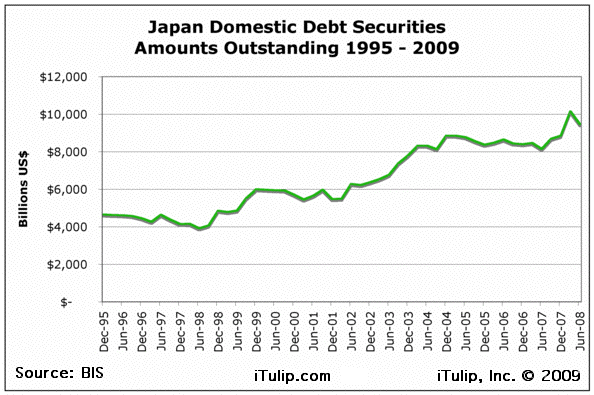
The yield on the benchmark 10 year Japanese government bond ranged between its deflationary 0.6% lows in 2003 to a peak of almost 2% in 2006.
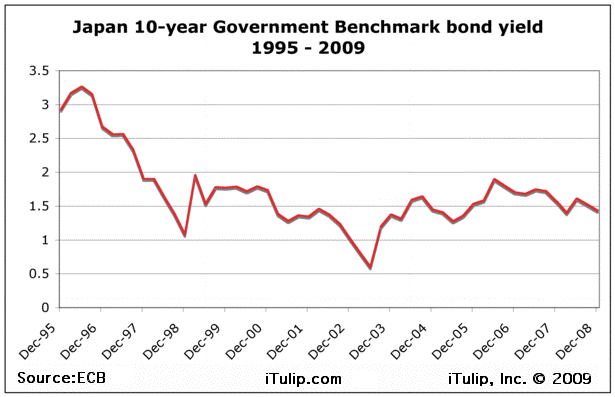
U.S. 10 year treasury bonds today are looking Japan 1998-ish.
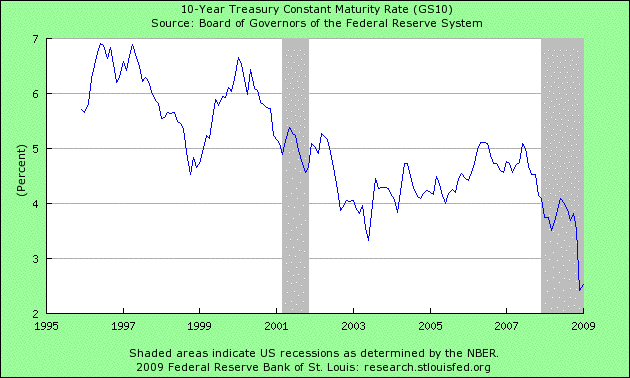
If the rush to Treasury bonds at the end of 2008 marked the beginning of a longer term trend away from risk, and if the risk-aversion period is anything like Japan's, it could go on for a decade. That does not strike us as a good shorting material.
No such thing as a bubble in government bonds
An asset bubble develops by a self-reinforcing process of optimism and inflation in the price of the asset of speculation, whether tech stocks, houses, or emerging market funds, as a growing pack of speculators, one group after another, piles in. Any number of loud noises can send the herd running, but we identified a list of usual triggers ten years ago (see What Will Pop the Internet Bubble?)
Global investors did not take to US Treasury bonds wild-eyed in pursuit of windfall gains in the closing quarter of 2008 hoping to get rich off debt securities heading to 0% yield any more than the passengers and crew of the Titanic who made it into life rafts paddled the dark sea that night for love of ice fishing. Investors desired safety of principal, to stay alive to fight another day.
No matter that the life rafts were cold and wet compared to the commodious staterooms that the passengers expeditiously abandoned, the rafts at least float; if the price of a life raft seat were open to bid the price might have been very high that night. But no sane person observing the spectacle of passengers abandoning an iron ship for open wooden boats bobbing in the open sea could mistake the resulting price spike in life raft seats for a frenzy of optimism. So with US Treasury bonds once emerging markets stocks, the yen carry trade, and the bubbles funded by central bank and credit market liquidity collapsed last fall, precipitated by a sudden withdrawal of creative credit from global markets, following the crash of the securitized debt market in the US the year before.
If not a Treasury bond bubble, then what?
For our analogy replace the Titanic with the stricken USS FIRE Economy. The securitized debt market is the iceberg that sank it, the frigid waters into which it sank the market for all equity and debt securities with the exception of the lifeboats -- US Treasury bonds. As US Treasury bonds are denominated in dollars, the rush for Treasury bonds corresponded to a spike in the demand for and price of dollars.
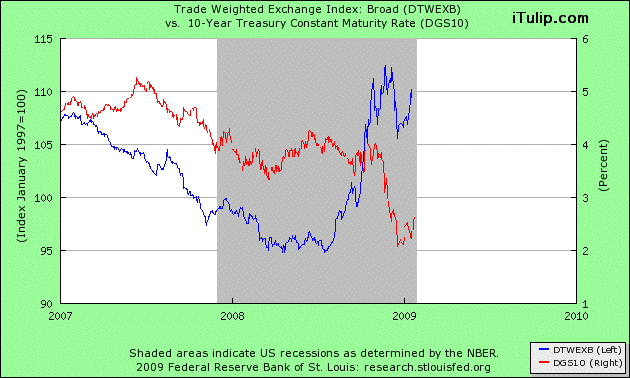
After the event, those who went for the Treasury bond life rafts still appear to some market observers to be too many, and to have bid up the price of seat to incredible heights, taking the dollar higher than it “should” go, given the exhaustively lamented structural weaknesses and recent abuse heaped on the buck by the Federal Reserve via debt monetization, promises by the government to spend up to its sovereign credit limit and beyond, and other extreme acts of desperate debt deflation acrobatics. The market for US government bond credit default swaps responded with a Bronx cheer.
In the past three months, the US Federal Reserve has created more credit than it has ever done before. The sum of its earning assets, known in trade parlance as reserve bank credit, has grown at the outstanding rate of 2,922 per cent. The CDS price of the US has risen to a record 57 basis points in the face of deteriorating credit conditions of banks and non-finance companies and concerns over the $1,000 billion it needs to raise in bonds to tide over the crisis. - Sunil Kewalramani, Will 2009 be the year of sovereign defaults? Business Standard, Jan. 24 2009
But where to go? Spanish sovereign bonds perhaps? Or French? German? Certainly not the bonds of the UK, where recently a loose lipped City Minister Paul Myners disclosed in a Daily Mail story that, “on Friday, October 10, the country was 'very close' to a complete banking collapse after 'major depositors' attempted to withdraw their money en masse,” and that the Brown administration was hours away from closing and nationalizing the entire banking system. While the US Treasury lifeboats may be leaky, the others are positively sieve-like. Municipal bonds, perhaps? With state and local tax revenues crashing, how will principal plus interest be paid on muni bonds, never mind the risks presented by the scandal in – you guessed it – credit default swaps sold during the day to “protect” cities and towns from interest rate volatility.
What might cause Treasury bond holders to leap en masse out of the life rafts and swim for it through the still frigid financial markets sea, to the rapidly submerging finance-based economy? Meanwhile, the financial markets, and thus the financed-based US economy, starves for capital for borrowing and investment. Debt deflation and asset price deflation continue unabated, while a crash in the supply of goods is resulting in the rising prices of goods that are not still temporarily on sale, as inventories are sold through (See Fed cuts dollar, Fire sales vs FIRE sales, Duh-flation, and Bezzle shrinks again).
Enter the gods of government: the Treasury Dept. and Federal Reserve. Their task: get fearful investors out of the Treasury bond lifeboats, into the frigid high risk financial markets sea to the sinking USS FIRE Economy – where they can be put to work re-floating it.
The gods of government have so far taken a two-pronged approach: send rescue ships and boil the ocean.
Send Rescue Ships
First the government gods send rescue ships bearing taxpayer money – trillions of dollars for insurance companies, banks, auto manufactures, the first class passengers of the sinking USS FIRE Economy to be rescued. Dispatched with haste starting in 2007 by a government gods Paulson and Bernanke determined to try to refloat the stricken ship and motivate investors who abandoned it to climb back aboard.
A measure of the ineffectiveness is S&P 500 and DJIA performance since then, both off more than 30% since the bailouts began. Mission not accomplished. An armada of rescue ships continues to steam toward the foundering USS FIRE Economy, including new forms of TARP, stretching as far as the eye can see.
Boil the ocean
Meanwhile, to entice terrified investors out of the Treasury bond life rafts, the gods turned up the heat on the frozen financial markets. Interest rates are determined by a mix of default and inflation risk, and while US Treasury bonds are “risk free” from default, they are exposed to inflation risk, as anyone who lived through the 1975 to 1980 era can attest. The financial markets ocean can be warmed from sub-zero temperatures (interest rates) by application of gigantic increases in the money supply (inflation), by exchange of Treasury bonds for securities that have no value until maturity -- those that create Credit Risk Pollution -- and buying across the yield curve. In theory, if the sea can be heated enough, the life raft squatters will climb out for a swim. The effort is the monetary equivalent of running 100 nuclear power plants at 100% capacity 7/24 for a year.
We look for on increase in ocean water temperature for signs that the ocean heating is working, as measured by a narrowing credit spread, as the price of a US Treasury life boat seat falls and seat in a riskier commercial paper markets narrows.
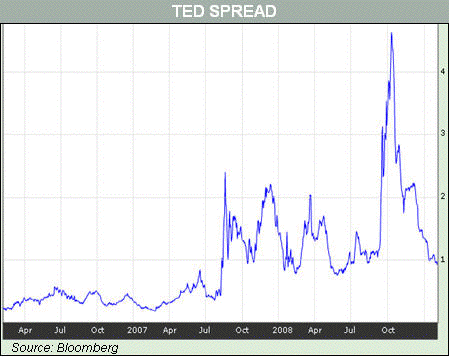
The ocean is no longer solid ice as it was in the fall of last year, but it’s not exactly Caribbean tepid yet, either.
What if the government gods’ combination of efforts to re-float the USS FIRE Economy and boil the ocean fail to get investors' money back into the economy?
Should they fail, the government still has one option left to get investors out of the Treasury bond life rafts, into the ocean, and back on the USS FIRE Economy.
Sink the rafts
The government gods want to entice capital out of low risk assets like government bonds and into risky assets like stocks. If that cannot be accomplished by making government bonds appear more risky than stocks, why not do it the other way around? Let us return to our Japan “bond bubble” example.
Japan’s 10-year bonds completed their biggest decline in a month after rising Asian stocks reduced demand for government debt.
Bonds slid for a fifth day, the longest losing streak since July 2007, after U.S. shares rallied yesterday when Treasury Secretary Timothy Geithner said the government will step up efforts to fight the recession. Demand for debt also waned after the Bank of Japan said yesterday it will start buying equities owned by financial institutions to shore up their capital. - Japan’s Bonds Complete Biggest Drop in a Month as Stocks Rise, Theresa Barraclough, Bloomberg, Feb. 4, 2008
Statements like the one below used to shock us, but not anymore. In the desperate global scramble by governments to re-inflate asset prices, anything goes.Bonds slid for a fifth day, the longest losing streak since July 2007, after U.S. shares rallied yesterday when Treasury Secretary Timothy Geithner said the government will step up efforts to fight the recession. Demand for debt also waned after the Bank of Japan said yesterday it will start buying equities owned by financial institutions to shore up their capital. - Japan’s Bonds Complete Biggest Drop in a Month as Stocks Rise, Theresa Barraclough, Bloomberg, Feb. 4, 2008
“We are facing hyper-deflation, so we need a policy to create hyper-inflation. We have to do something to undermine the central bank and government’s credibility or else we won’t be able to halt the yen’s rise. So, while we know this is drastic medicine, we will do it,” said Koutaro Tamura, an upper house Diet member who will chair the new group. - MPs step up clash with Bank of Japan, Michiyo Nakamoto in Tokyo, Financial Times, Feb. 5, 2009
If you wonder what is going on in Japan to inspire Japanese politicians to make public promises to override that nation's central bank, you have not been following Japan's stunning economic collapse.The numbers coming out of Japan are no longer about degradation, but historically unprecedented destruction. If the government pointers are correct, they are no longer suggesting a recession or even a depression of the style of the 1930s but something like a massive "Reset button" with very different and far-reaching consequences. This downward spiral is much faster, much more synchronised, resulting in an impact equivalent to one year's worth of declines in the 1930s on a monthly basis, month-in month-out. It is as if the whole country has been visited by an army of King-Kongs, who are busy destroying the industrial output.
Japan's industrial production fell almost 10% in December compared with November, worse than the METI (Ministry of Economy, Trade and Industry) forecast. METI has re-done its forecasts for January to a 9% drop, and February down another 5%. That knocks almost 30% output since September, putting it back, at the level of the early 1980s. It took 25 years to reach levels that have been unwound in five months. For carmakers, production may fall by around 50% from last year in 2009. There has never been data this bad for any major economy: even during The Great Depression of the 1930s. If METI's January and February industrial production data is correct, the proportions are apocalyptic. Masaaki Shirakawa, Bank of Japan Governor, recently warned, “The outlook for the Japanese economy has deteriorated dramatically and there is a high probability that it will continue to do so.” more...
There you have it, a way to get to get frightened investors out of government bonds and back into stocks if all else fails -- central banks around the world print money and buy stocks -- and a motive to do it, a rapid global economic contraction. Japan's industrial production fell almost 10% in December compared with November, worse than the METI (Ministry of Economy, Trade and Industry) forecast. METI has re-done its forecasts for January to a 9% drop, and February down another 5%. That knocks almost 30% output since September, putting it back, at the level of the early 1980s. It took 25 years to reach levels that have been unwound in five months. For carmakers, production may fall by around 50% from last year in 2009. There has never been data this bad for any major economy: even during The Great Depression of the 1930s. If METI's January and February industrial production data is correct, the proportions are apocalyptic. Masaaki Shirakawa, Bank of Japan Governor, recently warned, “The outlook for the Japanese economy has deteriorated dramatically and there is a high probability that it will continue to do so.” more...
Coming to a country and equity market near you.
In a world where interventionism is the order of the day, government purchases of stocks for the purpose of supporting the stock market is only, in my view, a matter of time. The question is, how to best prepare for it. For all we know, it's already started. And, because they are not really gods -- they can't foresee the consequences of all they do -- there will be myriad unintended consequences. One we're pretty sure of, the gold price will continue to climb.
Addendum
This forecast for governments to buy stocks does not translate directly into a decision to move money from Treasury bonds and gold into stocks.
For ten years iTulip has concerned itself with forecasting the future collective greed-fear and loss-fear actions of a poorly informed and unreasoning investing public during the final decade of the FIRE Economy, when a system of monetary policy, regulatory malfeasance, and government subsidy of the finance, insurance, and real estate industries produced asset price inflations as explained in detail in The Next Bubble. So far our record, based on this approach, has been good.
- November 1998: Warns on Internet Bubble
- August 1999: No Y2K Disaster
- November 1999: How the Internet Bubble Will End
- March 2000: Internet Bubble Top
- April 2000: A Bear Market is Born
- January 2001: Post-Bubble Recession
- September 2001: Gold Price Bottom at US$270
- August 2002: Warns of Housing Bubble
- January 2004: How Housing Bubble will End
- January 2005: Housing Bubble Correction
- June 2005: Housing Bubble Top
- October 2006: Recession Q4 2007
- December 27, 2007: Start of Debt Deflation Bear Market
- September 15, 2008: Fed Funds spread signals crash
Since the system that created the bubbles that we have tracked for ten years has broken down, we have been this year forced to extend our role of mass behavioral finance experts to include the role of Kremlinologists, as market forecasting becomes increasingly a matter of trying to determine second order effects: the reactions of a poorly informed and unreasoning public to the actions of a poorly informed and unreasoning government, whose failing effort to resurrect the FIRE Economy will be compounded by new policy errors guided by economic nationalism; as contracting national economies around the world enter into political crisis, politicians never blame themselves for their nation's economic woes, they externalize them.
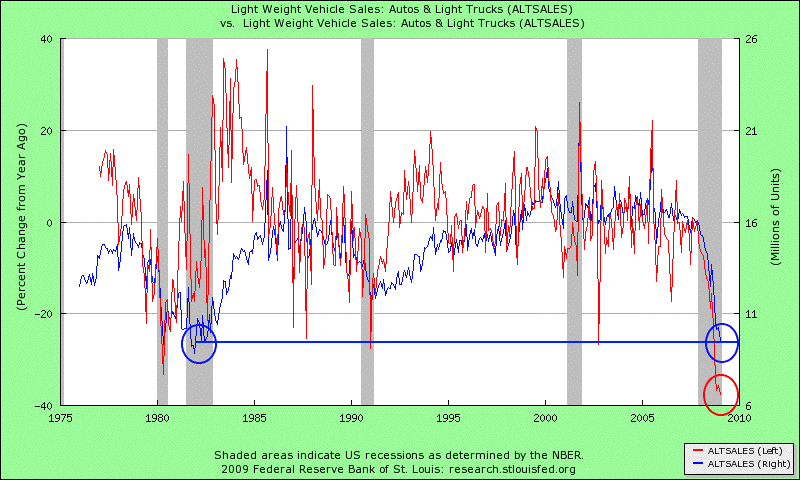
Our global trade and monetary policy bodies are designed to cope with the challenges of global growth. They are not equipped to handle prolonged global economic contraction. That means trade barriers will rise and global trade will diminish. This is not a positive development for stock values.
Also, the US is entering its own period of political crisis. The news headlines, already quite depressing, will become more alarming, with incidents occurring frequently that a year ago were unimaginable. The nation will grow less confident, and that too is not stock market value positive.
Another reason my forecast for governments to buy stocks does not necessarily recommend the purchase of stocks is that when governments buy anything, they must drain one value pool to fill another. Governments don't create anything, except when they provide and maintain a sound system of property rights, institutions, and legal and physical infrastructure that allows free markets to operate, and does so with minimal cost in a burden on businesses in taxes and debt. Government cannot "create" jobs, only borrow them from the future, or take them from one area of the economy and move them to another. Likewise the government cannot increase the value of stocks by buying them, as the Bank of Japan has on occasion, only increase the price. As most people mistake price for value -- if they did not, the technology stock and housing bubbles would never have occurred -- a rise in stock prices caused by government buying may fool investors into joining the market. Or maybe the government only succeeds in maintaining a floor on stock prices, as the BoJ seems to have gotten for their money. In any case, if the government buys stocks the value of stocks will decline just as the value of anything the government buys declines, even if the price rises.
A forecast of eventual government purchases of stocks does not translate into a recommendation to buy stocks. As usual, we are going to have to talk through the implications.
iTulip Select: The Investment Thesis for the Next Cycle™
__________________________________________________
To receive the iTulip Newsletter or iTulip Alerts, Join our FREE Email Mailing List
Copyright © iTulip, Inc. 1998 - 2009 All Rights Reserved
All information provided "as is" for informational purposes only, not intended for trading purposes or advice. Nothing appearing on this website should be considered a recommendation to buy or to sell any security or related financial instrument. iTulip, Inc. is not liable for any informational errors, incompleteness, or delays, or for any actions taken in reliance on information contained herein. Full Disclaimer
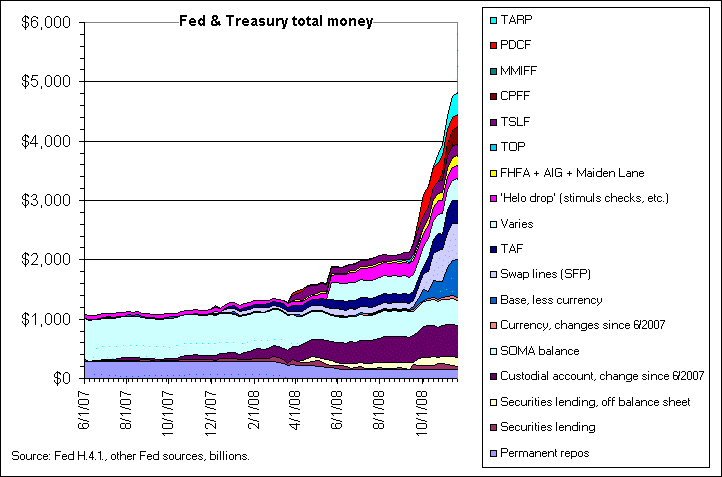

Comment